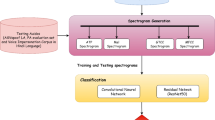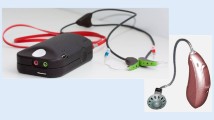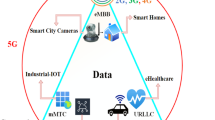Abstract
A new source coding is proposed for secure and robust speech communications. The method is based on the combination of compressed sensing and split-multistage vector quantization. The proposed codec is integrated in an end-to-end communication system, and its performance is investigated in real mobile communication conditions. Channel compensation techniques are considered to mitigate the Rayleigh channel effects usually observed in mobile communications. Using the proposed speech coding scheme instead of current standards (e.g., AMR-WB) within the communication system results in a new end-to-end mobile communication design. The proposed design increases the transmission speed, robustness, and security without additional costs. For a bit rate of 8.85 kbit/s and in 10 dB Rayleigh environment, the recovered speech has a good perceptual evaluation of speech quality score close to 3.14 and a fair coherence speech intelligibility index value of around 0.47. Comparison with recent CS-based speech coding methods shows the merit of the proposed coder.









Similar content being viewed by others
Data Availability
All data generated or analyzed during this study are included in this published article.
References
M.K. Al-Azawi, A.M. Gaze, Combined speech compression and encryption using chaotic compressive sensing with large key size. IET Signal Process. 12(2), 214–218 (2018). https://doi.org/10.1049/iet-spr.2016.0708
B. Bessette, R. Salami, R. Lefebvre, M. Jelinek, J. Rotola-Pukkila, J. Vainio, H. Mikkola, K. Jarvinen, The adaptive multirate wideband speech codec (AMR-WB). IEEE Trans. Speech Audio Process. 10(8), 620–636 (2002). https://doi.org/10.1109/tsa.2002.804299
V. Cambareri, M. Mangia, F. Pareschi, R. Rovatti, G. Setti, Low-complexity multiclass encryption by compressed sensing. IEEE Trans. Signal Process. 63(9), 2183–2195 (2015). https://doi.org/10.1109/tsp.2015.2407315
E.J. Candes, M.B. Wakin, An introduction to compressive sampling. IEEE Signal Process. Mag. 25(2), 21–30 (2008). https://doi.org/10.1109/MSP.2007.914731
H. Chen, C.H. Vun, A feature-based compressive spectrum sensing technique for cognitive radio operation. Circuits Syst. Signal Process. 37(3), 1287–1314 (2018). https://doi.org/10.1007/s00034-017-0610-x
D.L. Donoho, Compressed sensing. IEEE Trans. Inf. Theory 52(4), 1289–1306 (2006). https://doi.org/10.1109/TIT.2006.871582
M. Ferroukhi, A. Ouahabi, M. Attari, Y. Habchi, A. Taleb-Ahmed, Medical video coding based on 2nd-generation wavelets: performance evaluation. Electronics (2019). https://doi.org/10.3390/electronics8010088
J.S. Garofolo, L.F. Lamel, W.M. Fisher, J.G. Fiscus, D.S. Pallett, N.L. Dahlgren, DARPA TIMIT acoustic-phonetic continuous speech corpus (1993)
D. Giacobello, M.G. Christensen, M.N. Murthi, S.H. Jensen, M. Moonen, Sparse linear prediction and its applications to speech processing. IEEE Trans. Audio Speech Lang. Process. 20(5), 1644–1657 (2012). https://doi.org/10.1109/tasl.2012.2186807
H. Haneche, B. Boudraa, A. Ouahabi, Compressed sensing investigation in an end-to-end rayleigh communication system: Speech compression. In: 2018 International Conference on Smart Communications in Network Technologies (SaCoNeT), pp. 73–77. IEEE (2018). https://doi.org/10.1109/saconet.2018.8585702
H. Haneche, B. Boudraa, A. Ouahabi, A new way to enhance speech signal based on compressed sensing. Measurement 151, 107117 (2020). https://doi.org/10.1016/j.measurement.2019.107117
H. Haneche, A. Ouahabi, B. Boudraa, New mobile communication system design for Rayleigh environments based on compressed sensing-source coding. IET Commun. (2019). https://doi.org/10.1049/iet-com.2018.5348
Y. Hu, P.C. Loizou, Evaluation of objective quality measures for speech enhancement. IEEE Trans. Audio Speech Lang. Process. 16(1), 229–238 (2008). https://doi.org/10.1109/tasl.2007.911054
Y. Ji, W.P. Zhu, B. Champagne, Recurrent neural network-based dictionary learning for compressive speech sensing. Circuits Syst. Signal Process. 38(8), 3616–3643 (2019). https://doi.org/10.1007/s00034-019-01058-5
J.M. Kates, K.H. Arehart, Coherence and the speech intelligibility index. J. Acoust. Soc. Am. 117(4), 2224–2237 (2005). https://doi.org/10.1121/1.1862575
H. Mamaghanian, N. Khaled, D. Atienza, P. Vandergheynst, Compressed sensing for real-time energy-efficient ECG compression on wireless body sensor nodes. IEEE Trans. Biomed. Eng. 58(9), 2456–2466 (2011). https://doi.org/10.1109/tbme.2011.2156795
S. Mun, J.E. Fowler, Dpcm for quantized block-based compressed sensing of images. In: 2012 Proceedings of the 20th European Signal Processing Conference (EUSIPCO), pp. 1424–1428. IEEE (2012)
A. Ouahabi, Signal and Image Multiresolution Analysis (Wiley, Hoboken, 2012)
R. Paderna, D.Q. Thang, Y. Hou, T. Higashino, M. Okada, Low-complexity compressed sensing-based channel estimation with virtual oversampling for digital terrestrial television broadcasting. IEEE Trans. Broadcast. PP(99), 1–10 (2016). https://doi.org/10.1109/TBC.2016.2606938
A. Ravelomanantsoa, A. Rouane, H. Rabah, N. Ferveur, L. Collet, Design and implementation of a compressed sensing encoder: application to EMG and ECG wireless biosensors. Circuits Syst. Signal Process. 36(7), 2875–2892 (2017). https://doi.org/10.1007/s00034-016-0444-y
D.L. Ruyet, M. Pischella, Digital Communications 1: Source and Channel Coding, 2nd edn. (Wiley, Hoboken, 2015)
C. Salah-Eddine, B. Merouane, Robust coding of wideband speech immittance spectral frequencies. Speech Commun. 65, 94–108 (2014). https://doi.org/10.1016/j.specom.2014.07.001
D. Salomon, Data Compression: The Complete Reference, 4th edn. (Springer, London, 2007)
S. Sekkate, M. Khalil, A. Adib, Speaker identification for OFDM-based aeronautical communication system. Circuits Syst. Signal Process. (2019). https://doi.org/10.1007/s00034-019-01026-z
A. Shirazinia, S. Chatterjee, M. Skoglund, Joint source-channel vector quantization for compressed sensing. IEEE Trans. Signal Process. 6(14), 3667–3681 (2014). https://doi.org/10.1109/tsp.2014.2329649
L. Stanković, E. Sejdić, S. Stanković, M. Daković, I. Orović, A tutorial on sparse signal reconstruction and its applications in signal processing. Circuits Syst. Signal Process. (2018). https://doi.org/10.1007/s00034-018-0909-2
G.L. Stuber, Principles of Mobile Communication, 3rd edn. (Springer, New York, 2011)
M. Vanidevi, N. Selvaganesan, Channel estimation for finite scatterers massive multi-user mimo system. Circuits Syst. Signal Process. 36(9), 3761–3777 (2017). https://doi.org/10.1007/s00034-016-0489-y
M. Vidyasagar, An Introduction to Compressed Sensing (SIAM, Philadelphia, 2020)
A. Viterbi, Error bounds for convolutional codes and an asymptotically optimum decoding algorithm. IEEE Trans. Inf. Theory 13(2), 260–269 (1967). https://doi.org/10.1109/TIT.1967.1054010
J. Wang, Y. Lee, C. Lin, S. Wang, C. Shih, C. Wu, Compressive sensing-based speech enhancement. IEEE/ACM Trans. Audio Speech Lang. Process. 24(11), 2122–2131 (2016). https://doi.org/10.1109/TASLP.2016.2598306
T. Xue, X. Dong, Y. Shi, Multiple access and data reconstruction in wireless sensor networks based on compressed sensing. IEEE Trans. Wirel. Commun. 12(7), 3399–3411 (2013). https://doi.org/10.1109/TW.2013.060413.121184
A. Yang, A. Ganesh, Z. Zhou, S.S. Sastry, Y. Ma, Fast l1-minimization algorithms for robust face recognition. IEEE Trans. Image Process. 22(8), 3234–3246 (2013). https://doi.org/10.1109/TIP.2013.2262292
C. Ye, G. Gui, L. Xu, Compressive sensing signal reconstruction using l0-norm normalized least mean fourth algorithms. Circuits Syst. Signal Process. 37(4), 1724–1752 (2018). https://doi.org/10.1007/s00034-017-0626-2
Author information
Authors and Affiliations
Corresponding author
Additional information
Publisher's Note
Springer Nature remains neutral with regard to jurisdictional claims in published maps and institutional affiliations.
Rights and permissions
About this article
Cite this article
Haneche, H., Ouahabi, A. & Boudraa, B. Compressed Sensing-Speech Coding Scheme for Mobile Communications. Circuits Syst Signal Process 40, 5106–5126 (2021). https://doi.org/10.1007/s00034-021-01712-x
Received:
Revised:
Accepted:
Published:
Issue Date:
DOI: https://doi.org/10.1007/s00034-021-01712-x




